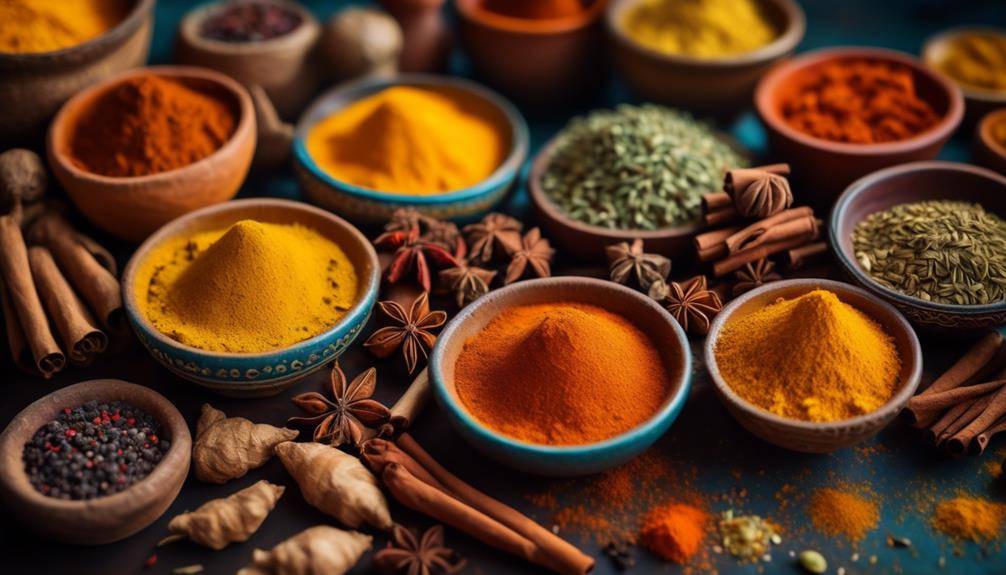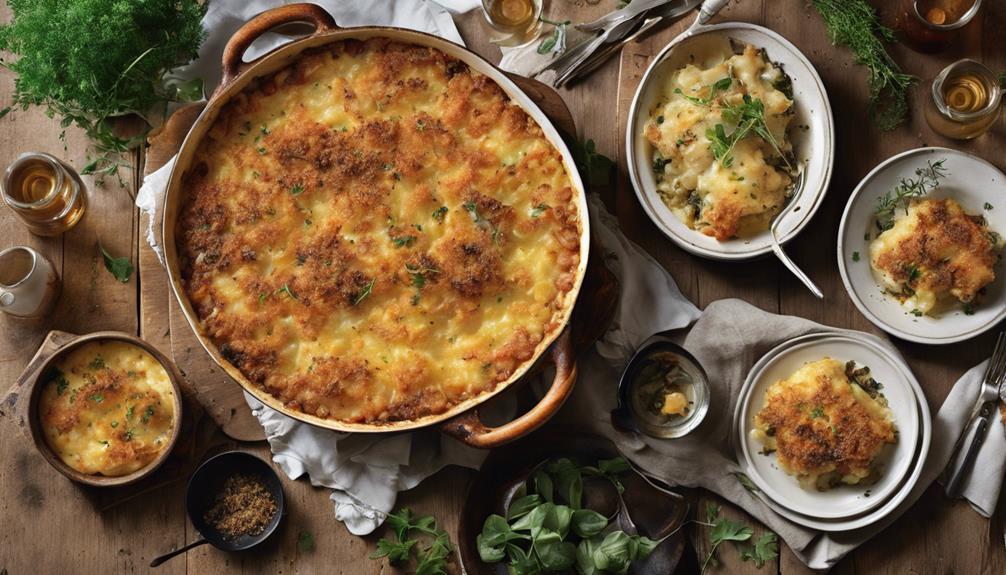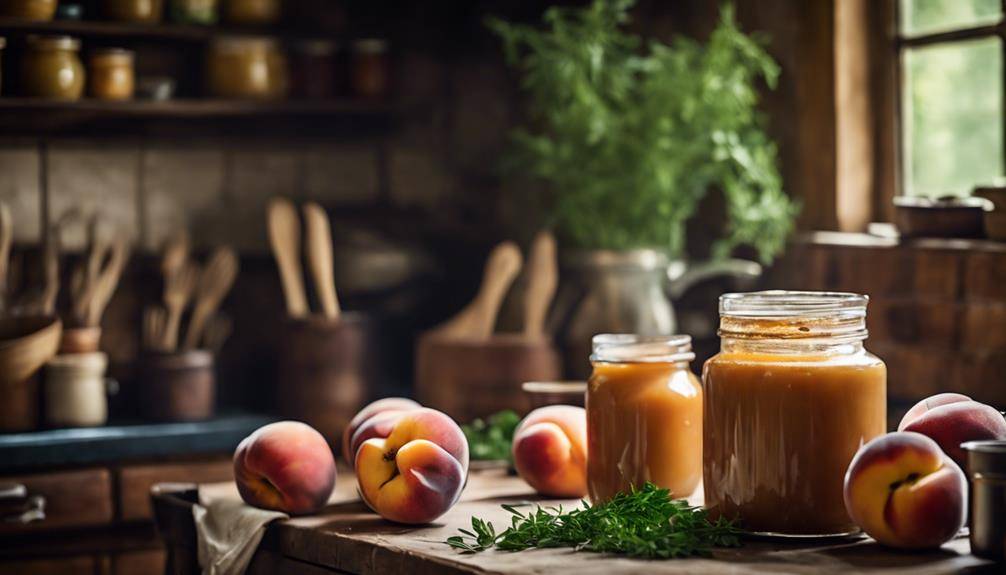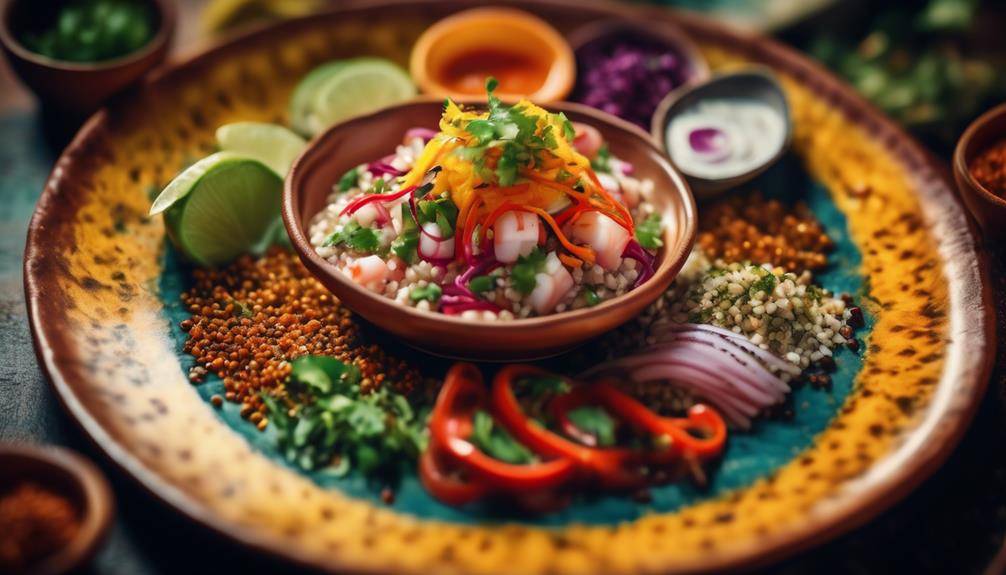The Best 10 Traditional Russian Comfort Food Recipes
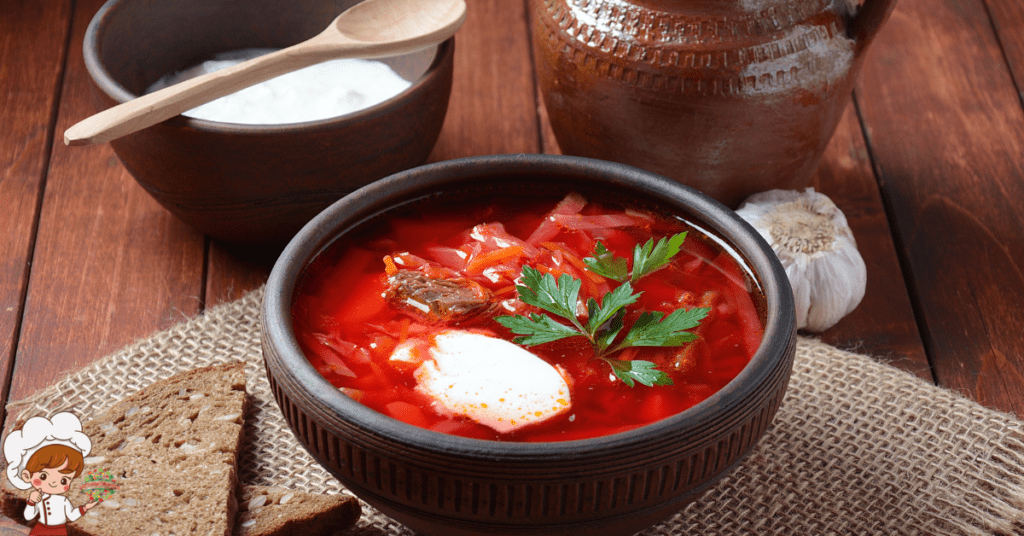
If you’re craving The Best 10 Traditional Russian Comfort Food Recipes, you’re in for a treat! Start with borscht, a vibrant beet soup, and enjoy hearty shchi, a cabbage soup perfect for chilly days. Don’t miss out on delicious pelmeni dumplings or sweet and savory vareniki. Treat yourself to thin, versatile blini pancakes, too. For a classic main dish, beef stroganoff’s creamy sauce is irresistible. You can also savor kasha porridge and the iconic Olivier salad. Finally, sip on kvass, a revitalizing fermented beverage. Each dish has its charm, inviting you to discover even more delightful recipes ahead!
Borscht
Borscht is a vibrant beet soup that’s a staple in Russian cuisine, often enjoyed hot or cold. You’ll love the rich, earthy flavor that beets bring to this dish, and you’ll be pleased to know that beets offer numerous health benefits. They’re packed with vitamins, minerals, and antioxidants, which can promote heart health and improve digestion. Plus, beets help lower blood pressure and boost stamina, making borscht not just delicious but also a nutritious choice.
When it comes to borscht variations, you’ll find that there are countless ways to prepare this beloved dish. Some recipes call for cabbage, carrots, and potatoes, while others may include meat, like beef or pork. You can even experiment with adding beans or other vegetables to customize it to your taste. Traditional recipes often feature a dollop of sour cream on top, which adds a creamy tang that perfectly complements the soup’s sweetness.
Don’t hesitate to adjust the seasonings either; dill, garlic, and bay leaves can elevate the flavor profile. If you’re feeling adventurous, try incorporating different spices or even a splash of vinegar for a unique twist. Whether you prefer a classic borscht or a modern variation, it’s a comforting dish that warms the soul. Enjoy the experience of making and savoring this iconic soup, and relish in the health benefits that come with each hearty bowl.
Pelmeni
Pelmeni are a beloved comfort food in Russian cuisine that you won’t want to miss. These delightful dumplings are not only satisfying but also incredibly versatile. To make pelmeni, you start with a simple yet important component: the pelmeni dough. This dough is typically made from flour, water, and a pinch of salt. You’ll want to knead it until it’s smooth and elastic, giving you the perfect base for your dumplings.
Once your pelmeni dough is ready, it’s time to get creative with the pelmeni fillings. Traditional fillings often include minced meat, such as beef, pork, or lamb, mixed with onion and spices for flavor. However, you can also experiment with vegetarian options like mushrooms, potatoes, or cheese. The key is to guarantee that your filling is well-seasoned, as this will elevate the overall taste of the dumplings.
After rolling out the dough and cutting it into circles, you’ll place a small spoonful of your chosen filling in the center of each circle. Fold the dough over and pinch the edges to seal them tightly. This process is not just about making a meal; it’s a chance to connect with family and friends, as pelmeni are often made together during gatherings.
Once you’ve shaped your pelmeni, you can boil or fry them to perfection. Serve them with sour cream or melted butter, and you’ll have a comforting dish that warms the soul. Enjoy your culinary adventure with pelmeni!
Blini
Blini are a delightful staple in Russian cuisine that you won’t want to overlook. These thin pancakes, often compared to crepes, are incredibly versatile and can be enjoyed at any meal. You can easily whip up a batch for breakfast, lunch, or dinner, and they make a fantastic addition to any gathering or holiday feast.
When it comes to blini variations, the options are endless. You can make them from wheat flour for a classic taste or opt for buckwheat flour for a heartier flavor. Some people even experiment with adding ingredients like herbs or spices directly into the batter, giving each batch a unique twist. If you’re feeling adventurous, try making mini blini for bite-sized snacks that are perfect for parties.
Now, let’s talk about blini toppings. Traditional toppings range from sweet to savory. For a sweet touch, you can spread sour cream or yogurt, drizzle honey, or top them with jam or fresh berries. If you prefer savory options, consider filling them with smoked salmon, caviar, or sautéed mushrooms. You could even stuff them with a rich cheese filling for an extra indulgence.
Whatever toppings you choose, blini are sure to impress. They’re not just delicious; they’re also a reflection of Russian hospitality and tradition. So grab your ingredients, and get ready to enjoy this comforting dish that’s perfect for sharing with family and friends!
Beef Stroganoff
Beef Stroganoff is a classic dish that combines tender beef with a rich, creamy sauce. You’ll want to explore the essential ingredients, understand the cooking techniques that bring it all together, and discover creative serving suggestions to elevate your meal. Let’s get started on this comforting and flavorful recipe!
Classic Ingredients Overview
When you immerse yourself in the world of Beef Stroganoff, you’ll encounter a harmonious blend of classic ingredients that define this beloved dish. At its core, tender beef is the star, typically cut into strips and seared to perfection. You’ll want to use cuts like sirloin or tenderloin, which offer a rich flavor and melt-in-your-mouth texture.
Next, you can’t overlook the role of mushrooms. They add an earthy depth, enhancing the traditional flavors that make this dish so comforting. Fresh, seasonal produce like onions and garlic brings a fragrant aroma, elevating the dish further.
Don’t forget the creamy sauce, often made with sour cream, which lends a luscious texture and tangy flavor. This balance of richness is key to achieving that authentic taste. Some recipes even incorporate mustard or Worcestershire sauce for an extra layer of complexity.
Cooking Techniques Explained
Creating a rich Beef Stroganoff requires mastering key cooking techniques that confirm each component shines. Start with sautéing techniques to confirm your beef strips are perfectly browned. This enhances flavor and texture, creating a delicious base for your dish. Next, consider marinating flavors; a brief soak in a mixture of vinegar, oil, and spices can elevate the meat’s tenderness and taste.
For the sauce, don’t overlook simmering secrets. After adding your broth and sour cream, let it gently simmer to meld the flavors, avoiding a rapid boil that could curdle the cream. If you want to add vegetables, use steaming tips to retain their color and crunch, enhancing the dish’s overall appeal.
While roasting essentials aren’t directly part of the Stroganoff, you might roast some mushrooms beforehand for an added depth of flavor. If you wish to experiment, try grilling basics with your beef for a smoky twist.
Serving Suggestions Ideas
After you’ve perfected the cooking techniques for your Beef Stroganoff, presenting it in a way that enhances its rich flavors is key. Start by choosing the right serving temperature; ideally, your dish should be served warm but not scalding. For meal presentation, consider a wide, shallow bowl to showcase the creamy sauce and tender beef.
Pair your Beef Stroganoff with a light soup, such as a classic borscht, to create a comforting meal. For side dishes, buttery mashed potatoes or egg noodles complement the dish perfectly, allowing the sauce to shine. You can also add a fresh green salad for a touch of brightness.
Don’t forget the garnish options! A sprinkle of fresh parsley or dill adds color and freshness that elevates the dish visually. For beverage choices, a glass of dry red wine or a cold kvass can enhance the flavors beautifully.
This dish is perfect for family gatherings or festive occasions. By thoughtfully considering these serving suggestions, you’ll create a memorable dining experience that friends and family will love. Enjoy your Beef Stroganoff in style!
Shchi
Shchi, a hearty cabbage soup, embodies the essence of traditional Russian comfort food. You’ll find it warming your soul on chilly days, offering a blend of flavors that feels like a hug in a bowl. The base of shchi typically includes fermented or fresh cabbage, which gives it a distinctive tang and depth. Depending on your preference, you can explore various shchi variations, such as adding potatoes, carrots, or even meat for a richer taste.
One of the great things about shchi is its versatility. You can easily modify the recipe to suit your dietary needs or available ingredients. For instance, if you want a vegetarian version, skip the meat and enhance the broth with aromatic herbs. You can also switch in seasonal vegetables, making it a dish you can enjoy year-round.
Not only is shchi delicious, but it also comes packed with nutritional benefits. Cabbage is a powerhouse of vitamins C and K, while the broth provides hydration and warmth. The addition of root vegetables adds fiber, promoting good digestion.
Whether you’re feeling under the weather or just want a comforting meal, shchi is sure to satisfy. So, gather your ingredients and let the simmering pot fill your kitchen with its inviting aroma. In no time, you’ll have a bowl of shchi ready to enjoy, bringing the essence of Russian home cooking right to your table.
Pirozhki
Pirozhki are delightful Russian pastries that come with a variety of fillings, ranging from savory meats to sweet fruits. You can choose to bake them for a lighter option or fry them for that irresistible crispy texture. Each method brings out unique flavors, making it fun to experiment with your favorite fillings and cooking styles.
Pirozhki Filling Variations
Have you ever wondered what makes pirozhki such a beloved comfort food in Russia? The answer lies in their diverse filling variations. You can choose from sweet fillings like jam, poppy seeds, or fruit, which satisfy your cravings for something decadent. On the savory side, options abound with meats, mushrooms, or cabbage, ensuring there’s something for everyone. If you’re leaning towards vegetarian choices, consider fillings like potatoes, spinach, or cheese, which are not only delicious but also pay homage to the region’s agricultural bounty.
Pirozhki’s regional variations highlight the historical significance of this dish. In some areas, you might find unique ingredients that reflect local tastes and traditions. The cooking methods also play a role; whether you prefer the crispy texture of fried pirozhki or the golden-brown finish of baked ones, each method brings out the flavors in its own way.
With so many filling options available, it’s no wonder pirozhki are cherished across generations. So, why not try making your own pirozhki with a filling that speaks to your heart? You’ll discover just how comforting these little pastries can truly be!
Baking vs. Frying Methods
When it comes to preparing pirozhki, the choice between baking and frying can greatly influence the final taste and texture. Baking techniques tend to produce a lighter, fluffier pastry, allowing the filling’s flavors to shine through without overwhelming the senses. If you prefer a healthier option, baking is often the way to go. You’ll find that baked pirozhki have a golden crust that’s less oily, making them a delightful snack or meal.
On the other hand, frying comparisons reveal a whole new world of flavor. Frying pirozhki gives them a crispy, golden exterior that contrasts beautifully with the soft interior. This method enhances the overall richness, immersing you in that classic comfort food experience. The oil infuses the dough, adding a satisfying depth to each bite.
Ultimately, your choice may depend on the occasion. If you’re preparing a cozy family meal, baked pirozhki might fit the bill. But for a special treat or gathering, fried pirozhki could impress your guests. Whichever method you choose, you’re in for a delicious experience!
Kasha
Kasha, a staple in Russian cuisine, refers to various types of porridge made from grains like buckwheat, barley, or millet. It’s not just a dish; it’s a comforting meal that warms you from the inside out. To get started with kasha preparation, you’ll want to choose your grain. Buckwheat is a popular choice due to its rich, nutty flavor. Rinse the grains under cold water to remove any impurities before cooking.
For the basic kasha preparation, use a ratio of 1 part grain to 2 parts water or broth. Bring the liquid to a boil, add your rinsed grains, and then reduce the heat to a simmer. Cover and cook until the grains are tender and the liquid is absorbed, typically around 15-20 minutes. Fluff it with a fork, and you’re ready to go!
Now, let’s talk about kasha toppings. The beauty of kasha lies in its versatility. You can go sweet or savory depending on your mood. For a sweet version, add a dollop of honey, a sprinkle of cinnamon, and some fresh fruits or nuts. If you’re in the mood for something savory, sautéed mushrooms, caramelized onions, or a pat of butter can elevate the dish. You might even add a poached egg on top for a hearty breakfast. No matter how you dress it up, kasha is sure to become a favorite comfort food in your kitchen!
Olivier Salad
Olivier Salad is a staple in Russian cuisine with a rich history that dates back to the 1860s. You’ll find its essential ingredients include boiled potatoes, carrots, pickles, and meat, but there are plenty of variations to explore. Let’s take a closer look at how this beloved dish has evolved over the years.
History of Olivier Salad
Originating in the late 19th century, Olivier Salad has become a staple of Russian cuisine, celebrated for its rich flavors and variety of ingredients. You might be surprised to learn that the salad’s origins trace back to a French chef named Lucien Olivier, who created the dish in his Moscow restaurant, Hermitage. Originally, it featured luxurious ingredients like game, crayfish, and homemade mayonnaise, making it a dish of the elite.
As time went on, the salad evolved, leading to numerous salad variations. During the Soviet era, the recipe transformed to accommodate more accessible ingredients, like boiled potatoes, carrots, peas, and pickles. This shift allowed Olivier Salad to become a beloved dish across all social classes in Russia.
Today, you’ll find Olivier Salad gracing tables during celebrations and holidays, symbolizing unity and festivity. Each family often has its own twist on the classic recipe, incorporating different meats or vegetables. While the core elements remain the same, the creativity in preparation reflects the ongoing love for this traditional salad. So, whether you’re enjoying it at a family gathering or trying it for the first time, savor the history and heart behind Olivier Salad.
Essential Ingredients Required
To recreate the beloved Olivier Salad at home, you’ll need a blend of ingredients that brings the dish to life. Start with the essentials: boiled potatoes, carrots, and peas. These vegetables form the base of your salad, providing texture and heartiness. Next, add diced pickles for that signature tang, and don’t forget the cooked chicken or ham for protein.
You’ll also want to incorporate boiled eggs, which lend creaminess and depth. For the dressing, a mix of mayonnaise and sour cream works wonders, adding richness to the salad.
Now, let’s talk about vital spices. A pinch of salt and pepper is essential for enhancing the flavors. You might also consider adding a dash of mustard for an extra kick, depending on your taste.
Lastly, gather your pantry staples, like onions and fresh herbs, to finish the dish. Chopped dill or parsley can elevate the salad, giving it a fresh burst. With these ingredients in hand, you’re well on your way to crafting a traditional Olivier Salad that’s sure to impress. Enjoy the process and savor the delicious results!
Variations and Twists Available
Many home cooks love to experiment with the classic Olivier Salad, adding their unique flair to this traditional dish. You can easily incorporate healthier alternatives by swapping out some of the heavier ingredients for lighter ones, like using Greek yogurt instead of mayonnaise. Regional specialties can also inspire your variations, such as adding pickled vegetables common in different areas of Russia.
Don’t forget to use seasonal ingredients for freshness. Modern adaptations might include fusion flavors, like a dash of spicy Sriracha or citrus zest for an unexpected twist. If you’re looking for vegetarian options, consider replacing meat with chickpeas or tofu, ensuring the dish remains hearty.
Cooking shortcuts can help streamline your meal prep; pre-chopped veggies and canned beans can save you time while still delivering flavor. Feel free to experiment with ingredient substitutions using pantry staples—like substituting regular potatoes with sweet potatoes for a different taste. With so many ways to personalize Olivier Salad, you’ll never run out of ideas to keep this comforting classic exciting!
Vareniki
Vareniki, a beloved dish in Russian cuisine, are delightful dumplings that can be filled with a variety of ingredients, from potatoes and cheese to cherries and blueberries. You’ll find that the varieties of vareniki are nearly endless, allowing you to tailor them to your taste preferences. If you’re in the mood for something savory, opt for fillings like mashed potatoes, cottage cheese, or sautéed mushrooms. For a sweet treat, you can use fruits such as strawberries, raspberries, or even sweetened curd cheese.
Making vareniki is a fun and rewarding experience. Start by preparing a simple dough using flour, eggs, and water, then roll it out and cut it into circles. Place your chosen filling in the center, fold the dough over, and pinch the edges to seal. Cooking them is just as easy—boil them until they float, which usually takes about 5-7 minutes.
When it comes to vareniki serving ideas, you can’t go wrong with a dollop of sour cream on top or a sprinkle of fried onions for savory options. If you’re enjoying sweet vareniki, consider drizzling them with honey or adding a dusting of powdered sugar. You can also serve them alongside a fruit compote for a rejuvenating contrast. Whether you enjoy them as a main dish or dessert, vareniki are sure to become a cherished part of your culinary repertoire.
Kvass
Kvass is a traditional Russian fermented beverage that offers a unique blend of flavors and invigorating qualities. It’s often made from rye bread, which gives it a rich, slightly sweet taste with a hint of tanginess. You might be surprised to learn that kvass has been enjoyed for centuries, evolving through various recipes and methods that reflect the essence of traditional brewing in Russia.
To make kvass at home, you’ll need just a few ingredients: stale rye bread, water, sugar, and yeast. Start by toasting the bread until it’s dark and crunchy; this will enhance the flavor. Then, combine the toasted bread with hot water and let it steep, allowing the sugars to dissolve and infuse into the water. Once it cools, add sugar and yeast, stirring gently to combine. Cover the mixture and let it ferment at room temperature for a day or two, depending on how strong you want the flavor to be.
After fermentation, strain the liquid into bottles, leaving some space at the top. You can even add fruits, like raisins or berries, for a delightful twist. Seal the bottles and refrigerate them. In just a few days, you’ll have a revitalizing and fizzy kvass ready to enjoy.
Served chilled, kvass is perfect on its own or as a complement to hearty meals. This fermented beverage not only quenches your thirst but also connects you to a rich culinary tradition that’s been cherished through generations.
Frequently Asked Questions: 10 Traditional Russian Comfort Food Recipes
What Is the History Behind Traditional Russian Comfort Food?
You’ll find that traditional Russian comfort food reflects cultural significance and history. Each dish showcases regional variations, highlighting local ingredients and customs, making every bite a journey through Russia’s diverse culinary landscape and rich heritage.
How Do I Store Leftover Russian Dishes?
To store leftover dishes, place them in airtight storage containers. Refrigerate for up to three days. When reheating, use the microwave or oven, ensuring the food heats evenly to maintain its flavor and texture.
Are There Vegetarian Versions of These Recipes?
Yes, there are vegetarian adaptations of these recipes! You can easily swap meat with plant-based substitutes like tofu or lentils, ensuring you still enjoy the rich flavors without sacrificing your dietary preferences.
What Drinks Pair Well With Russian Comfort Food?
When enjoying Russian comfort food, consider vodka pairings for a classic touch or embrace tea traditions for a warm, soothing experience. Both options enhance the flavors and create a cozy atmosphere for your meal.
Can I Find These Ingredients Outside of Russia?
Yes, you can find these ingredients outside of Russia by exploring local markets and specialty stores. If needed, don’t hesitate to use local substitutes. Ingredient sourcing might be challenging, but it’s definitely possible with some effort.
Conclusion
Now that you’ve explored these delicious traditional Russian comfort food recipes, it’s time to get cooking! Each dish brings a unique taste and warmth that’s perfect for sharing with family and friends. Whether you’re simmering borscht or frying blini, you’re sure to create memorable meals that celebrate Russian culinary traditions. So gather your ingredients, roll up your sleeves, and enjoy the delightful flavors of Russia right in your own kitchen. Happy cooking!



